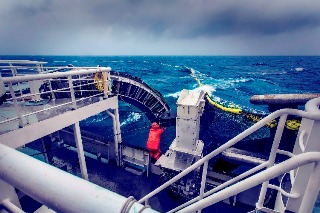Nov 7 2014
Robots equipped with machine vision enable us to classify catches on board vessels with high levels of accuracy – saving fishing crews time and money.
 Catch quality and weight distribution are currently determined on the basis of manual computations carried out on board. Photo:TYD
Catch quality and weight distribution are currently determined on the basis of manual computations carried out on board. Photo:TYD
When pelagic fish such as herring and mackerel are coming to market, auctions are hectic and time is short. Price is determined by the volume of the catch and its weight distribution.
"The purchaser wants the fish to be the right size so that he can avoid tasks such as resetting his production line machinery. They have to know what they're buying – and quickly", explains Aleksander Eilertsen, a researcher at SINTEF.
Catch quality and weight distribution are currently determined on the basis of manual computations carried out on board. This is very time-consuming, and there is pressure to come up with the answer as quickly as possible. This makes the calculations something of a lottery.
"A mistake can lead to heated discussions about the purchase price when the catch is landed for weighing checks. A vendor may find himself in the position of selling something he doesn't have", says Eilertsen.
Enormous catch volumes
This is why SINTEF, as part of a development project funded by the Norwegian Fishery and Aquaculture Research Fund (FHF), has produced a "proof-of-concept" system for making automatic catch weight estimates, which can be installed on fishing vessels. The system will now be put into commercial operation.
"We believe this system will be very useful because pelagic fish are caught using purse seines. These nets can be as much as one kilometre in circumference when deployed, and a single cast can result in a catch of up to 1000 tonnes. This is an enormous volume of fish, and means that the margins of error in any weight estimates can be very significant", says Eilertsen.
The new system automatically takes random samples of fish for weighing and then sends them back to the catch tank. 3D machine vision allows the weight distribution (spread of fish sizes) to be calculated, and also ensures that the species is identified and any damage recorded.
"In the past it has been essential to separate all the fish in order to handle them individually. However, on-board 3D scanning makes this no longer necessary", explains Eilertsen.